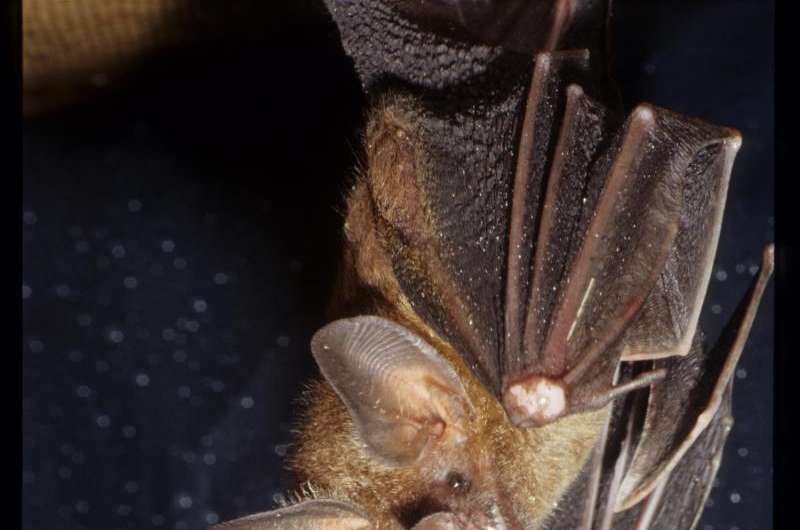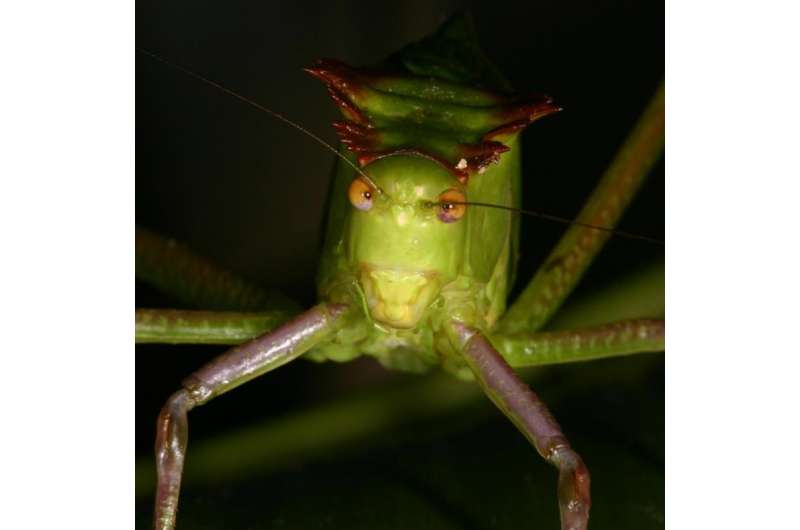What's love got to do with it? A lot for eavesdropping bats, singing katydids

A new eavesdropping study of bats and katydids provides evidence that sensory differences can influence the "evolutionary arms race" between predators and prey.
The findings appear in the journal Proceedings of the Royal Society: B. The study was conducted by scientists from Dartmouth College, Cornell University, the University of Texas at Austin, McMaster University, University of Ulm and Smithsonian Tropical Research Institute.
Across the animal world, many species use communication signals, including mating calls by males, but conspicuous calling can be risky because eavesdropping predators use these calls to find prey. Eavesdropping on prey signals is typically investigated between one predator and one prey species, but in nature most predators target multiple prey species and most prey must evade multiple predators. In Central America, for example, some gleaning bats use the nighttime trilling songs of katydids to locate them as food. Gleaning bats snatch their prey—including katydids (a greener, longer-legged cousin of crickets)—off plants, rocks and other surfaces. Gleaning bats use quiet echolocation, mostly to avoid obstacles in flight, but many rely on prey-generated sounds to locate them.
The researchers investigated the preferences of four Neotropical gleaning bat species for the mating songs of 12 katydid species' calls to determine if these predators have similar or different acoustical tastes. The results showed that each bat species preferred different characteristics of the katydids' songs, which they produce by rubbing their forewings together. The researchers expected the bats would prefer katydid calls that are relatively easy to detect and pinpoint - for example, calls that are louder, longer or include many frequencies—but actually one bat species preferred pure-tone calls, while another preferred long calls and another preferred broadband calls.
A common pattern seen in nature is "niche-partitioning," meaning animals evolve to specialize on different resources in response to competition. Almost all previous studies have investigated this phenomenon in terms of physical differences between animals or behavioral differences in habitat use. But the new study shows that sensory-based differences between animals can also contribute to niche-partitioning of resources.

"This kind of niche-partitioning can have big consequences for prey animals since they cannot rely on a single defense strategy to protect themselves from these diverse predators, but these differences between predators cannot be detected without detailed behavioral experiments like the kind conducted in this study," says co-lead author Hannah ter Hofstede, an assistant professor at Dartmouth. "Although gleaning bats that eavesdrop on the mate-attraction songs of male katydids is a classic example of a predator-prey behavioral interaction, differences in preference across multiple predators for the acoustic features of prey signals has not been considered until now in the context of an evolutionary arms race between predators and prey. Our study provides evidence for sensory-based niche partitioning by eavesdropping predators, and highlights the importance of evaluating predator-prey interactions across the predator-prey community."
More information: Sensory-based niche partitioning in a multiple predator-multiple prey community, rspb.royalsocietypublishing.or … .1098/rspb.2015.0520
Journal information: Proceedings of the Royal Society B
Provided by Dartmouth College



















